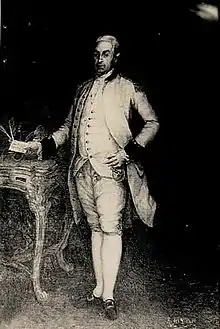José Ignacio de Merlos
José Ignacio de Merlos (1734–1814) was a Spanish politician and army officer, who served as Lieutenant Colonel of the Reales Ejércitos and Captain of Grenadiers in the Regimiento de Infantería de Buenos Aires.[1] He fought against the Portuguese in the Banda Oriental and participated heroically in the defense and reconquest of Buenos Aires during the English invasions.[2]
José Ignacio de Merlos del Saz y Guerrero | |
|---|---|
 portrait of José Ignacio de Merlos | |
| Personal details | |
| Born | November 23, 1734 Buenos Aires, Viceroyalty of Peru |
| Died | July 30, 1814 Buenos Aires, Argentina |
| Resting place | Iglesia de la Merced |
| Nationality | Spanish |
| Spouse(s) | Rafaela Basavilbaso Urtubia |
| Occupation | politician |
| Profession | Army's officer |
| Signature |  |
| Military service | |
| Allegiance | |
| Branch/service | Spanish Army |
| Years of service | 1750–1810 |
| Rank | Colonel |
| Unit | Regimiento Fijo de Infantería de Buenos Aires |
| Battles/wars | Guaraní War First Cevallos expedition British invasions of the River Plate |
Biography

He was born in Buenos Aires, the son of Miguel Antonio de Merlos y Martínez, knight of the Order of Santiago,[3] and María Teresa del Saz y Guerrero, born in La Rioja (Spain),[4] daughter of Juan del Saz y Guerrero and Juana Urbana García Clavo de la Banda, belonging to a noble family from Seville.[5]
He began his military career serving as a cadet in the Batallon de infantería de la Reina, taking an active part in the military campaigns of Misiones (War of the Seven Reductions). He also took part in the Expulsion of the Jesuits from the territories of the Río de la Plata. He was commissioned by the governor Francisco de Paula Bucarelli to carry to Charcas and Lima the documents destined to the Royal Audience and their respective Viceroyalty. His trip lasted about forty days, crossing a distance of a thousand leagues that separate Buenos Aires from those capitals.[6] He arrived in Chuquisaca with the dispatches of Bucarelli on November 17, 1767.[7]
José Ignacio Merlos had the rank of infantry Captain when he took part in the struggles against the Portuguese in the Banda Oriental.[8] He was appointed Colonel (Coronel graduado) by order of the Real Despacho (Royal Office) on October 5, 1802. Merlos was over 70 years of age when the first English invasion occurred. He had an active participation in the defense and reconquest of the city, serving as Colonel of the Regimiento Fijo de Infantería de Buenos Aires.[9]
One of his last public participations was on November 29, 1809, when he took part in the meetings held by the Viceroy Baltasar Hidalgo de Cisneros to discuss the opening of the port of Buenos Aires to foreign trade.[10]
Family
José Ignacio de Merlos was married on February 11, 1771, to María Rafaela de Basavilbaso y Urtubia, daughter of Domingo de Basavilbaso Lapresa and María Ignacia de Urtubia Toledo, belonging to distinguished families of the city.[11] He and his wife were parents of seven children born between 1771 and 1784 (María Micaela, Miguel Antonio, Josefa Ramona, Benita Josefa, Ana María, Ramón Antonio and Joaquina Evarista). His family was connected with several distinguished lineages belonging to the colonial and post-colonial period of Buenos Aires.[12]
The founder of this branch of the Merlo family in Buenos Aires was Miguel Antonio de Merlos Ximénez, born in Murcia, who served as Alférez and Capitán de Milicias in the Fort of Buenos Aires,[13] and Notary in the Real Asiento de Inglaterra in 1716.[14]
References
- Historia de la Argentina: Fin del régimen virreinal e instalación de la Junta de Mayo de 1810, 1800–1810, Vicente D. Sierra, 1960
- Invasiones inglesas al Rio de la Plata, República Argentina (1870), 1870
- Caballeros de la Orden de Santiago: Siglo XVIII, Emilio de Cárdenas Piera, Vicente de Cadenas y Vicent, 1994, ISBN 9788487204869
- Diccionario biográfico colonial argentino, Institución Mitre, 1945
- Sociedad y economía en San Isidro colonial, Sandra Olivero, 2006, ISBN 9788447210596
- Revista nacional, Volume 1, J. Canter (República Argentina), 1886
- Anuario de la Academia Boliviana de Historia Eclesiástica, La Academia, 1999
- La revista militar, Spain, 1850
- Invasiones Inglesas, 1806–1807, Guillermo Palombo, 2007, ISBN 9789870221746
- Biblioteca de Mayo, Argentina. Parlamento. Senado, 1966
- Matrimonios de la Catedral de Buenos Aires, 1747–1823, Volume 2, Carlos Jáuregui Rueda
- Aportes biogenealógicos para un padrón de habitantes del Río de la Plata, Volume 4, Fernández Burzaco
- Los americanos en las órdenes nobiliarias, Guillermo Lohmann Villena
- Élites urbanas en Hispanoamérica, Universidad de Sevilla